
Why are superconductors and their applications such a challenging subject to teach? Francesco Grilli, a researcher and professor from the Karlsruhe Institute of Technology (KIT), has an idea as to why — and a solution to the problem. By building simulation applications and making them available in a web browser, Grilli helps present this complex topic in a captivating way to encourage students to stay focused and interested in learning more about superconductivity. (You, fellow COMSOL Blog reader, can also access the apps via the link toward the end of the post!)
An Age-Old Breakthrough Advances Modern-Day Technology
Superconductors, first discovered in 1911 by Dutch physicist Heike Kamerlingh Onnes, have played a key role in the development and enhancement of several modern, high-tech devices. For example, in 2008, after 10 years of development, the world’s largest and most powerful particle accelerator, the Large Hadron Collider (LHC), was put in operation. The goal of its creation is to answer unresolved physics-related questions, especially ones relating to Higgs boson, subatomic particles, and dark matter. An important component behind the operation of this machine, as you may have guessed, is superconductors — specifically, a 27-kilometer ring of superconducting magnets.
Tip: See how modeling and simulation can be used to analyze superconducting magnets for use in particle accelerators, like the LHC, in our blog post “Simulating the Electrothermal Transients in Superconducting Magnets”.
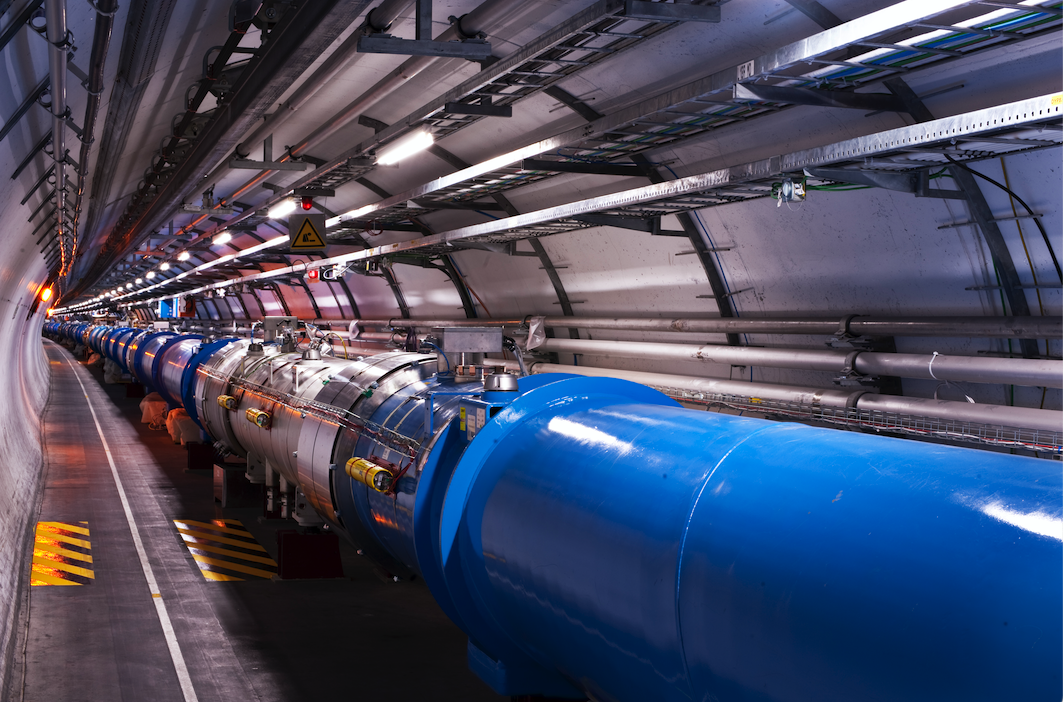
A section of the Large Hadron Collider’s tunnel. Photo by Maximilien Brice (CERN), licensed under CC BY-SA 4.0, via CERN.
Superconductors are also used in hospitals worldwide in a life-saving medical diagnostic tool: the magnetic resonance imaging (MRI) system. Superconductors enable MRI systems to produce very strong and stable magnetic fields, which in turn allow these systems to function with both extreme accuracy and precision, making them safe for patient use.
As new inventions frequently stem from and build on the ideas of past thought leaders, it is no surprise that an over-100-year-old discovery is helping to progress modern technology. However, it is surprising that the role of superconductivity and the multidisciplinary impact that this technology has on the world is overlooked during lectures.
To learn more, we spoke with Francesco Grilli, a Karlsruhe Institute of Technology (KIT) researcher and professor.
The Evolution of Superconductors
“Mercury was the first element that was discovered to be a superconductor,” said Grilli, who leads a group at KIT that focuses on the numerical modeling of superconductors, from materials to large-scale applications. Grilli has been modeling the electromagnetic and thermal behavior of superconductors and the characterization of their properties for the last 20 years. “[These] materials can carry electric energy without dissipation under certain conditions,” he explained.
The discovery of the first superconductor came when Onnes submerged a wire made of solid mercury into liquid helium. To his surprise, he found that the electrical resistance in the wire disappeared when it was immersed in the liquid and subjected to a temperature of 4.2 K (or a few degrees above absolute zero). With this, he discovered “superconductivity”, or the ability of certain materials to conduct electricity without energy loss and expel magnetic fields when they are exposed to very low temperatures.
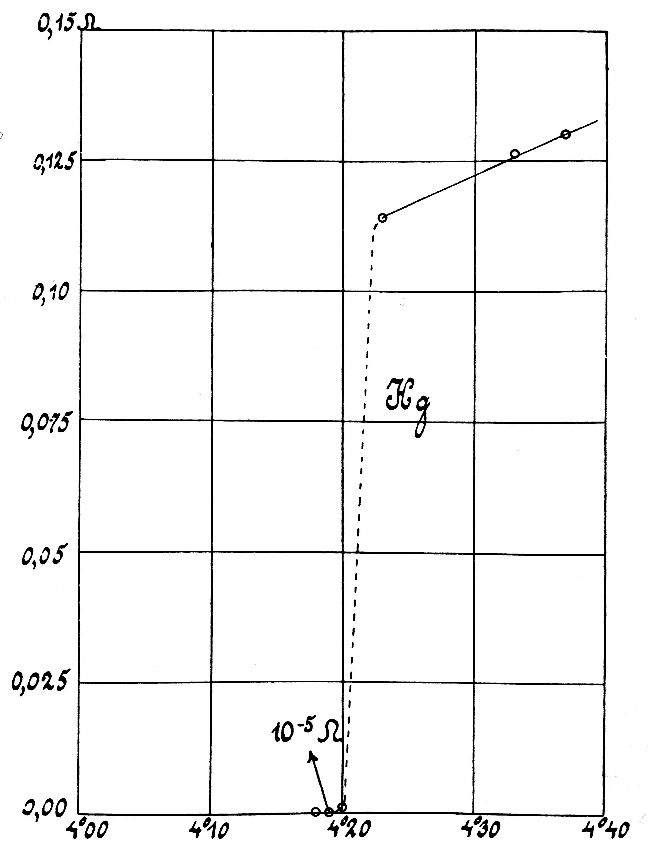
The original plot showing the sudden disappearance of the electrical resistance in a mercury sample cooled below its critical temperature. Image in the public domain, via Wikimedia Commons.
In addition to mercury, there are many other elements on the periodic table that can become superconductors if they are sufficiently cooled, including, but not limited to, aluminum, tin, and lead. Most of these are known as type-I superconductors. However, according to Grilli, these simple elements cannot be used in real-world devices because even a very small magnetic field — in the range of few tens of millitesla (mT) — can destroy their superconductivity. To put this into perspective, the field produced by toy magnets, often found on refrigerator doors, is in the range of a few millitesla. This clearly demonstrates that type-I superconductors are not suitable for high current applications, let alone for making powerful magnets.
If that’s the case, then how are superconductors being used in technology today? This is where type-II superconductors come in. This is a class of materials that behave differently and are more complex, with examples including alloys and ceramic compounds. They are often industrialized and can be purchased in the form of a wire from a variety of retailers. Unlike type-I superconductors, type-II are frequently used in real-world applications. For example, niobium–titanium, a type-II superconductor, is the material that enables MRIs to function properly.
Still, even superconductors made of alloys have their limits. “If you want [a superconductor] that operates at higher temperatures and produces even larger magnetic fields, those materials are not good enough,” said Grilli. The groundbreaking finding of high-temperature superconductors (HTS), discovered in 1986 by physicists Johannes Georg Bednorz and Karl Alexander Müller, helps address this issue. “These are not the metallic alloys; these are something more complex,” said Grilli.
Compared to previous superconductors, which only work around -270°C to -250°C, HTS can function at warmer temperatures of around -200°C. “[This temperature] is still very low, but you can use liquid nitrogen to reach it. Liquid nitrogen is a very cheap and easy-to-handle cryogenic liquid,” Grilli explained. Therefore, high-temperature superconductors are more affordable and practical, making them a go-to choice for future innovations, such as commercialized nuclear fusion technology, compact medical devices, and electric aircraft.
The Challenges of Teaching Superconductivity
The material properties of superconductors and the complexity of certain wire and cable geometries are two aspects that make them a difficult subject to teach. In particular, a peculiar aspect of superconductors that sets them apart from conventional material is their electromagnetic behavior, which is very specific and different from that of conventional conductors, like copper. “The main difference being that the resistivity of superconductors [unlike conventional conductors] depends very dramatically on how much current is put through them in a very nonlinear way,” explains Grilli. This makes understanding the behavior of superconducting applications quite challenging, especially for students with limited background knowledge of applied superconductivity. Simulations can help a lot, but existing models used for conventional materials need to be properly adapted or completely rethought. More granular challenges that lecturers like Grilli face revolve around keeping learners interested, engaged, and, most importantly, inquisitive.
“In my courses, I like to let my students explore practical scenarios, and simulation is a good way of providing that experience,” he said. However, time is limited for such classroom exercises, and Grilli has found that even an activity for building a simple model will often take longer than anticipated. He explained that during a model-building activity, the main challenge that students face is getting distracted by smaller workflow tasks. “I wanted to use something that allowed students to focus on the physics and results [as well as] the importance of the phenomena that we described and less on the formal aspects of going through the menus, naming the variables, using the correct syntax of the computer language, [and so on.]”
Grilli wondered: Was there a better way to bring simulation into the classroom?
Finding a Solution with Simulation Apps
Grilli turned to the idea of using simulation apps as a teaching tool. To help bring his vision to life, Grilli worked with Nicolò Riva and Bertrand Dutoit, both of whom have an extensive list of published work on superconductivity and superconductor modeling. Together, they built AURORA, an open-access web server that contains a variety of simulation apps for solving problems involving type-I and type-II superconductors.
AURORA was created by first developing simulation apps using the Application Builder in the COMSOL Multiphysics® software and then making them available using the app-management product COMSOL Server™. They installed AURORA at the Swiss Federal Institute of Technology Lausanne (EPFL), a place where both Riva and Dutoit have close ties: the former received their PhD in electrical engineering for applied superconductivity there and the latter works there as a senior scientist.
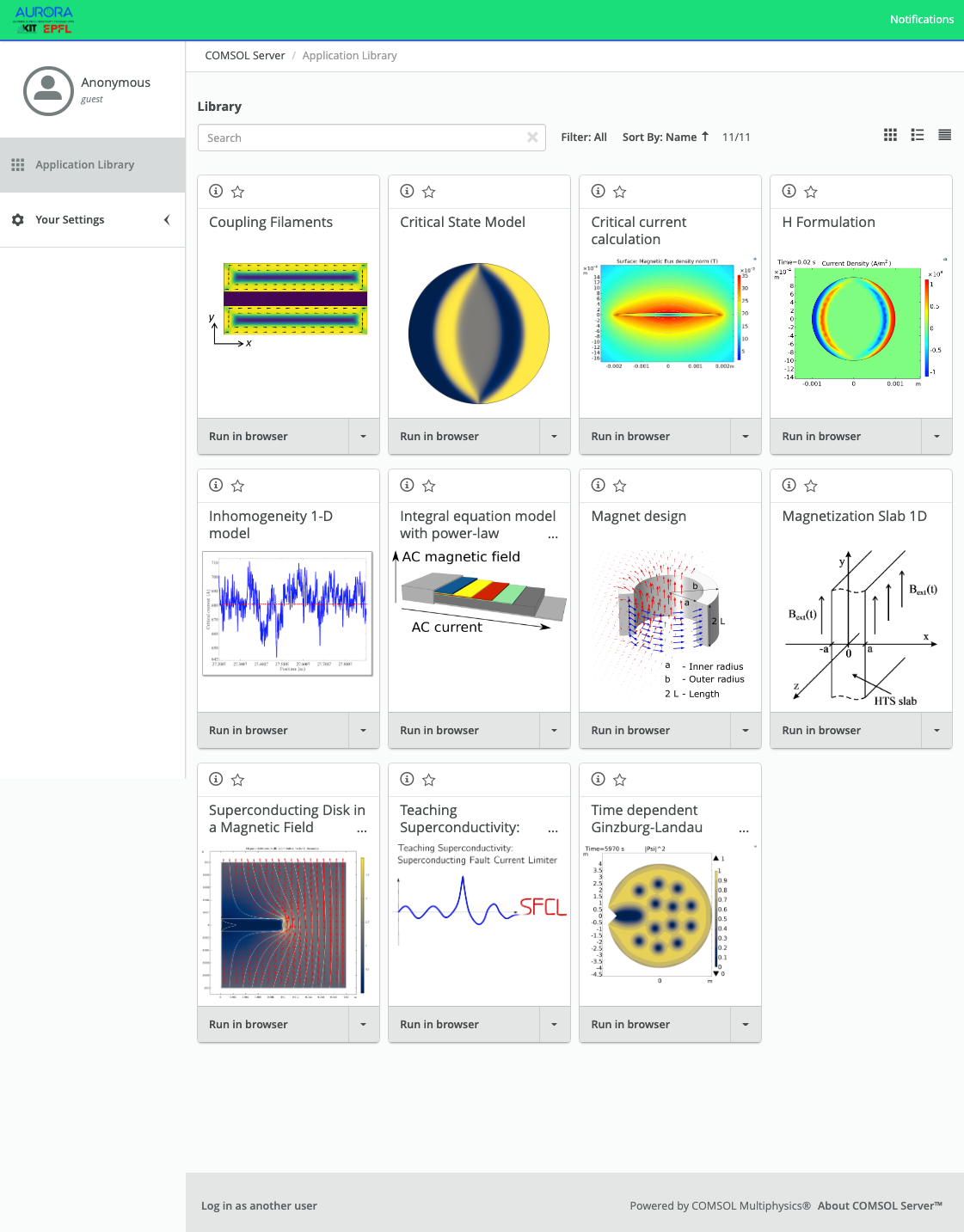
The AURORA server with its many simulation apps.
“COMSOL apps are useful because I can limit what the students see, and let them test only with certain parameters,” said Grilli. The custom user interfaces of the apps help students focus on the parameters and quantities of interest, creating a vivid learning experience without having to first learn how to use simulation software.
Students also benefit from the ease of access that AURORA and its library of simulation apps provide, as it can be accessed by anyone, anywhere, from a web browser via a phone, computer, or tablet. This accessibility has helped Grilli teach superconductor concepts to those outside of KIT as well. “I teach not only at my university but am also invited to do some guest lectures [at other universities]. I wanted something that is portable in an easy way.” With AURORA, Grilli now has a platform of simulation apps that can easily be used by students, no matter which university they attend.
“The advantage [of simulation apps] is that students can use them to understand several things about the performance of superconducting applications. Although the cases that are simulated are very simple, I hope that they can help the students understand the importance of some aspects in real [superconducting] applications,” said Grilli.
Exploring the Apps and Accessing the Server
AURORA currently consists of 11 simulation apps that can be used for analyzing the electromagnetic and thermal behavior of superconductors at different scales. There’s an app for simulating a superconducting sample exposed to a magnetic field, another for modeling the magnetic field distribution in a magnet, and more. Although the apps were designed for electrical engineering students, anyone who wants to learn more about superconductors and the global importance and impact of superconductivity could find them of interest. The computational time for all of the apps is under 4 minutes, with the shortest being 2 seconds.
You can access them directly via the open-access AURORA server, but I’d like to highlight a couple of the apps below as well.
Simulation App: Time-Dependent Ginzburg–Landau
When in the presence of magnetic fields, superconducting materials have the ability to exclude them. However, when these fields exceed a certain strength, they can enter the material. This scenario can be modeled with the Ginzburg–Landau equations, named after physicists Vitaly Ginzburg and Lev Landau. The Time-Dependent Ginzburg-Landau app can be used to visualize this process in both type-I and type-II superconductors. With the app, users can modify the following parameters:
- The applied magnetic field
- The radius of the superconducting sample
- Ginzburg–Landau parameter , which determines whether a superconductor is type-I or type-II
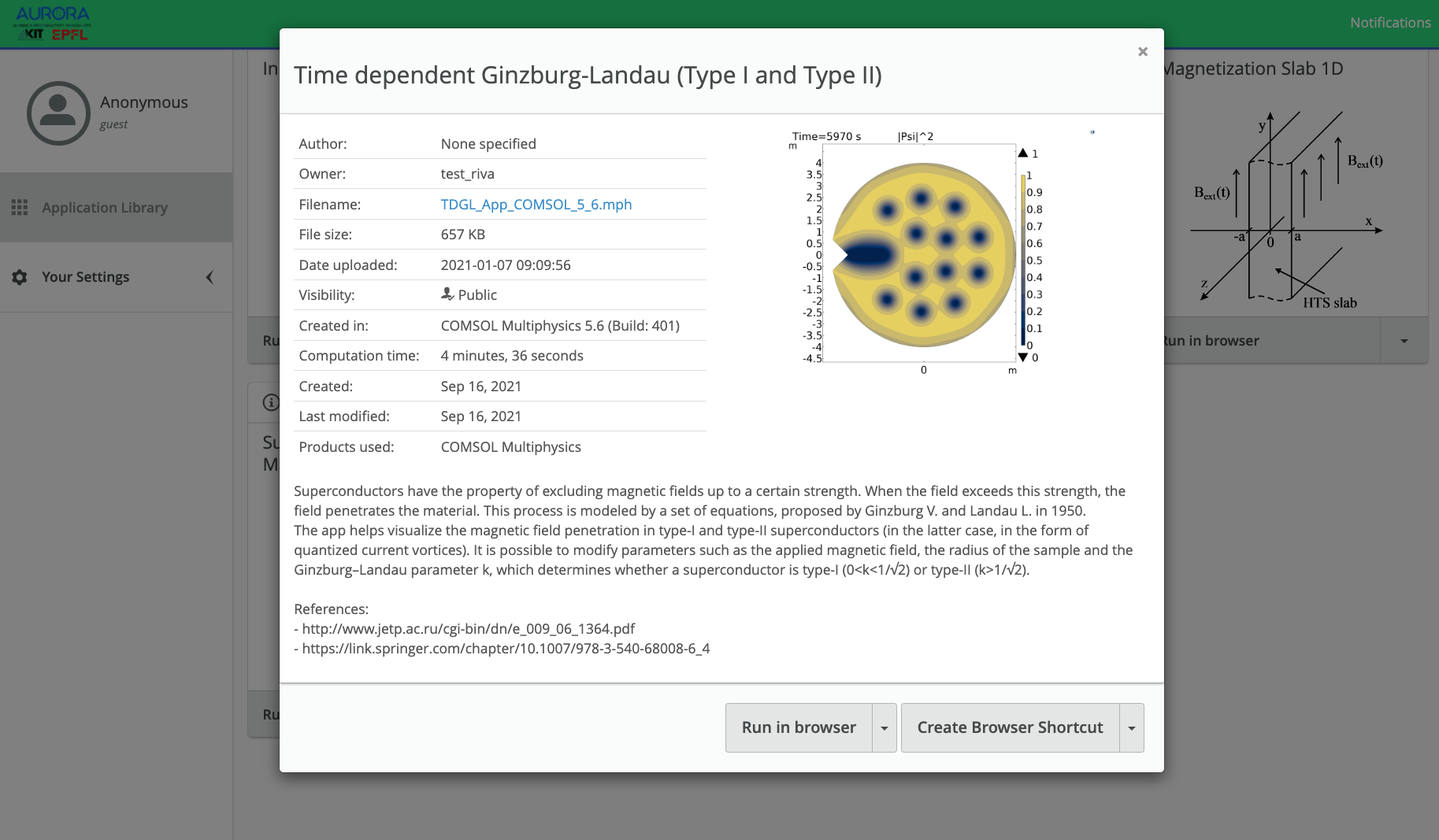
The Time-Dependent Ginzburg-Landau app, accessible via the AURORA server.
See this app in action below.
Simulation App: Magnet Design
Superconductors are most frequently used in magnet applications, such as for MRI systems and particle accelerators. With the Magnet Design app, users can see the magnetic field distribution in a superconducting magnet, in particular, a solenoid-shaped magnet. The magnet, modeled as a hollow cylinder, includes inner radius a, outer radius b, and length 2 L, as shown below.
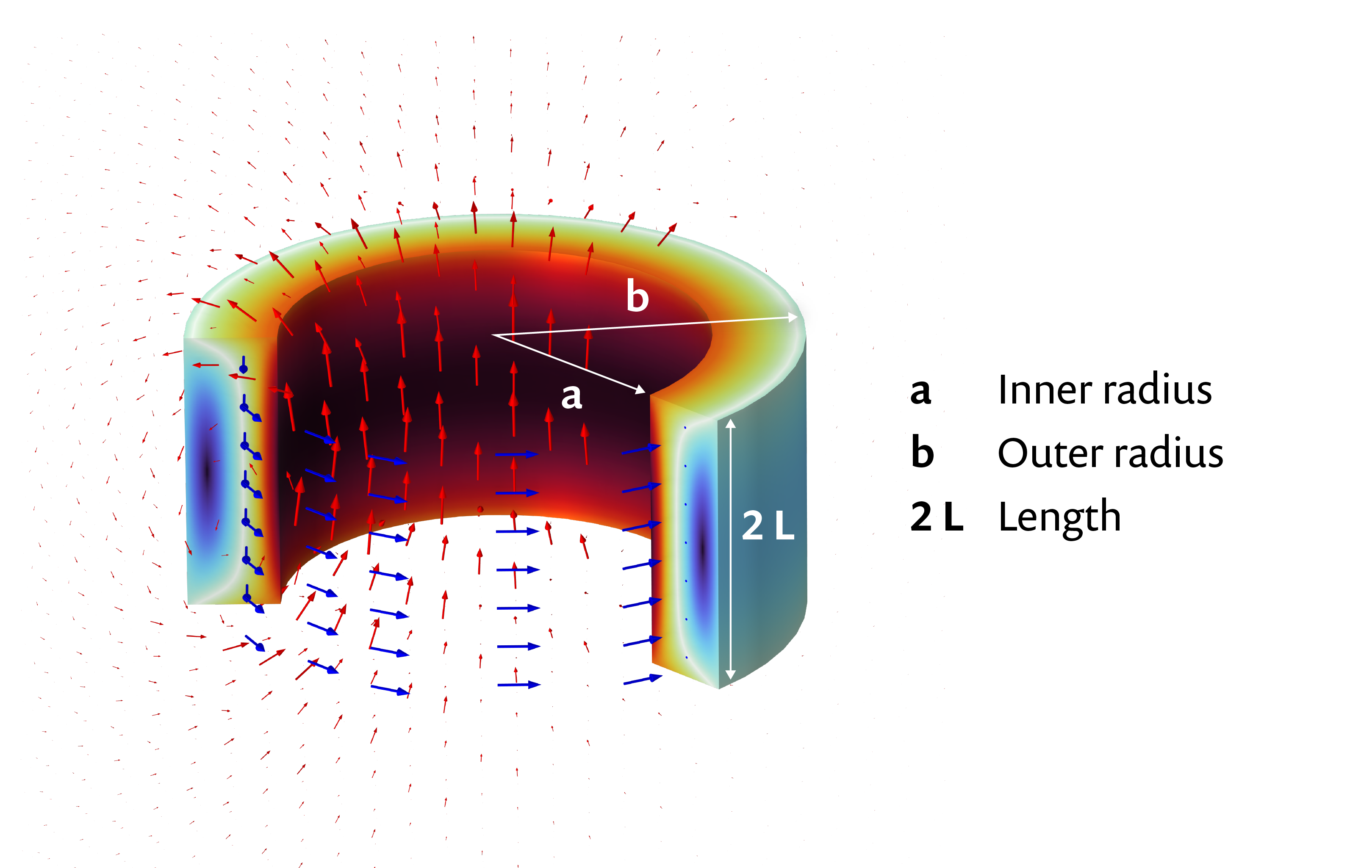
The inputs of the app enable users to change the magnet’s geometry, the uniform current density applied to the magnet’s cross section, and the area of the wire’s cross section used for the winding. An important aspect of the app is that it explores how the magnet’s shape affects the magnetic field’s uniformity, a property used to find the maximum current a superconductor can operate at.
The Magnet Design app in action.
View all of the apps made available by Grilli and try them yourself on the AURORA server. These apps can be run directly from a browser by anyone, anywhere; no installation is required (Ref. 1). For one of them, which simulates the electrothermal behavior of a HTS wire in a superconducting fault current limiter, there is also a dedicated article (see Ref. 2).
AURORA: A Word with Numerous Interpretations
When deciding on a name for AURORA, Grilli, Riva, and Dutoit wanted it to closely relate to the main goal of the platform: to encourage individuals in (and out of) the classroom to explore superconductors and stay inquisitive about how these materials work. After compiling a list of keywords related to their mission, they came up with the name AURORA, which stands for leArning sUpeRcOnductivity thRough Apps.
Aurora is also the name of the goddess in Roman mythology who is known for “opening the path to the sun and a new day”; the server AURORA was created with the hopes of opening a path for a new generation of students to learn about superconductors in an engaging and thought-provoking way (Ref. 1).
Suggested Resources
- Check out the AURORA server
- Browse more examples of how simulation applications are being used in the classroom on the COMSOL Blog:
References
- Nicolò Riva et al., “AURORA: a public applications server to introduce students to superconductivity,” J. Phys.: Conf. Ser., 2021; https://doi.org/10.1088/1742-6596/2043/1/012005
- Nicolò Riva et al., “Superconductors for power applications: an executable and web application to learn about resistive fault current limiters”, European Journal of Physics, 2021; https://doi.org/10.1088/1361-6404/abf0da




Comments (1)
COLLER PATER
April 28, 2023Aurora is a name with various meanings and origins. It can be a Latin name meaning “dawn” or “daybreak,” or it can be derived from the name of the Roman goddess of the dawn, Aurora. In some cultures, it can also mean “light” or “brilliance.”
we are a Leading 100% pure sunflower oil supplier from Sweden at the best competitive prices. Our team comprises experts from Indonesia and our Premium vegetable oil supersede all EU Standards. at best competitive prices.Please check our website below for more details, and can give you the best prices on our high-quality cooking oil
Tel/Whatsapp: +41 77816 5334
https://kgalyncha.com/product/refined-corn-oil/